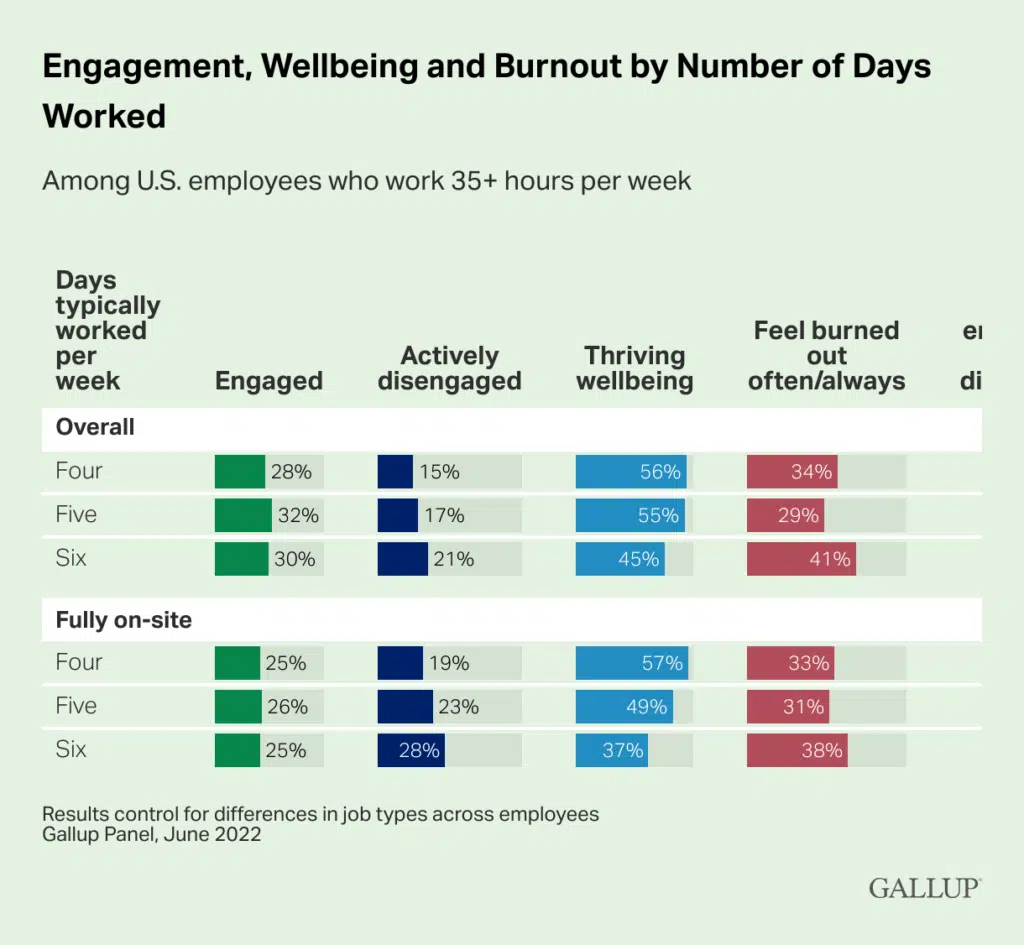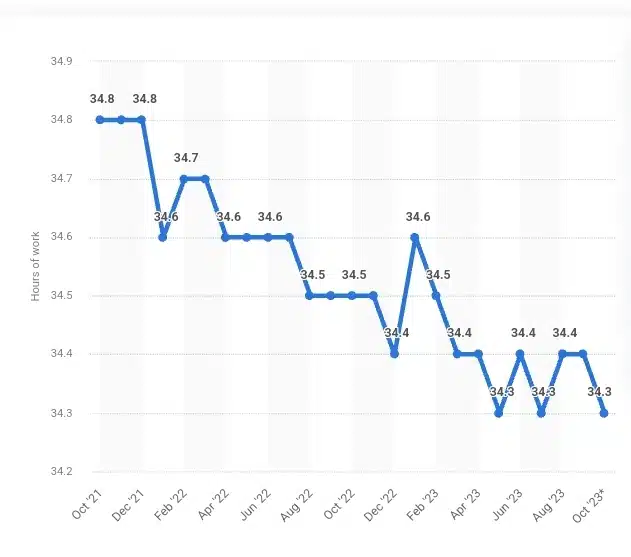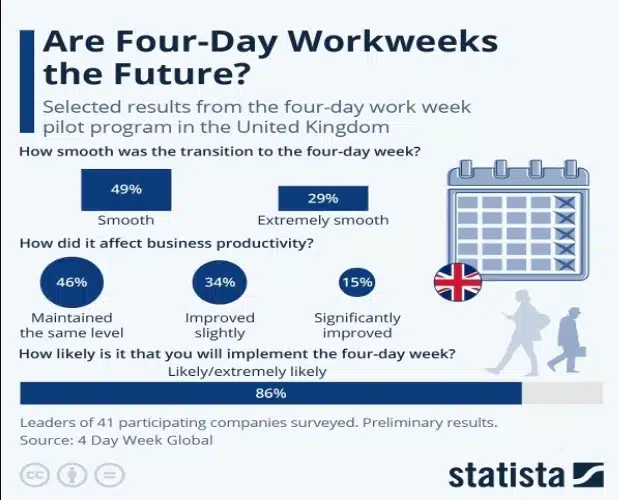
There’s a dread that comes whenever it is Monday. This is because it marks the beginning of 5 or 6 days of constant work, which can be stressful.
But what happens when you can have only four work days and enjoy three days off? Yes, this is called the 4-day workweek schedule.
4-day workweek schedules have existed for years, but they only recently became a trend.
Over the years, more companies have experimented with the schedule of only four working days. Most of them responded positively and hoped to continue it instead of the traditional five-day workweek.
But don’t just take my word for it; explore the latest 4-day work week statistics to get more insights into how companies are receiving the concept.
If you are considering adopting a 4-day workweek schedule for your organization, you need to keep reading to learn more about what it entails.
What Does a 4-day Work Week Mean?
A 4-day work week is a schedule where employees work four days a week instead of the traditional five while maintaining a standard total number of weekly work hours.
This can lead to longer daily work hours but allows for an extra day off each week.
Employees will focus on completing their tasks within four days instead of 5, so they can have three days off. This will not affect their pay either.
4-day Work Week Statistics You Should Know
1. 81% of full-time workers prefer a 4-day workweek. Out of this 81%, a majority (89%) of them are more than willing to make sacrifices to get it. For example, 54% say they are ready to work longer hours. (source)
2. 67% of workers say they want a 4-day workweek, 10 hours per day. (source)
3. 92% of companies involved in a 4-day workweek experiment say they plan on continuing the method. The experiment showed that a shorter workweek boosted productivity, team culture, and morale. (source)
4. 93% of U.S. managers would like their team to have a 4-day workweek. Additionally, 64% of them expect their organization to adopt the 4-day workweek mode within the next few years. (source)
5. Additionally, 66% of workers agree that working only four days would improve their mental well-being. (source)
6. 66% of workers say they prefer to spend their fifth day (Friday) with friends. 67% prefer to spend time with their families. (source)
7. According to Gallup research, only 8% of over 12,300 surveyed employees say they work four days weekly. Also, 84% had the traditional five-day workweek, while 8% worked six days weekly. However, the 6-day workweek employees experienced very high rates of burnout. (source)
8. 4-day workweek workers have less work engagement rates compared to 5 and 6-day workweek. (source)

9. Up to 44% of on-site employees would change their jobs to enjoy a 4-day workweek. (source)
10. 15% of the surveyed employees admitted that no amount of money would make them go back to working five days a week. (source)
11. 40% of companies in a survey have either implemented a 4-day workweek or have begun to do so. (source)
12. In Poland, 28% of surveyed workers prefer a 4-day workweek. (source)
13. Over 32% of employees in the U.S. between 58 and 76 years prefer a 4-day workweek. This percentage makes them the age group with the highest desire to want a 4-day workweek. However, the age group with the lowest desire is those between 18 and 25 years old. (source)
14. In the UK, the average work hours per week is 36.4 hours. (source)
15. In a survey, 54% of Irish and German workers prefer a shorter workweek than a longer salary. (source)
16. According to 96.5% of employees who want a 4-day workweek, the primary reason for wanting that is because they want more time for themselves. However, a smaller number (31%) of employees say they want a shorter workweek due to health issues. (source)
17. In Hungary, one-fourth (25%) of employees admitted that “the introduction of a 4-day workweek was a dream”. Another 25% say they are willing to change jobs just to enjoy a 4-day workweek. (source)
18. Over 64% of businesses in the U.K. support the introduction of a 4-day workweek. Only 28% opposed it, preferring the traditional five or six-day workweek. (source)
19. Also, the same recent survey showed that larger businesses favored having a 4-day workweek, with 76% selecting the notion. Microbusinesses were also in support but with only 53%. (source)
20. Most countries have adopted a 4-day workweek, but none have done so entirely. Some of these countries include Australia, Austria, Belgium, Canada, Denmark, etc. (source)
21. According to a Gartner poll, 63% of surveyed employees say part of their top innovative benefit that would attract them to a job is having a 4-day workweek with the same pay. (source)
22. Top companies offer a 4-day workweek (source). Some of the top companies that have a 4-day workweek policy include:
- Amazon
- Basecamp
- Samsung
- Microsoft
- Panasonic
- Bolt
- Toshiba
- Buffer
- Forbes Advisor, etc
23. Up to 20% of surveyed companies in the UK say they currently operate on a 4-day workweek schedule. Additionally, 41% say they plan to implement a shorter workweek for their employees. (source)
24. Although many business leaders would like a 4-day workweek, only 31% agree that all their employees are eligible for a 4-day workweek. Over half (55%) of the leaders say 75% of their staff are eligible to work only four days a week. However, 9% agree half of their employees can have a 4-day workweek, and 6% believe less than 25% of their staff can do so. (source)
25. According to the surveyed business leaders, the top determinants for eligibility are level of responsibility (64%), work location (52%), work performance (51%), and employee’s department (45%). (source)
26. The current average weekly work hours in the U.S. is 34.4 hours. (source)

27. Although the 4-day workweek trend has been in existence for many years, a majority of companies are just starting to implement it recently. 54% of businesses using a 4-day workweek schedule admit they have been doing so for a short time, six months to 2 years. Also, 18% say they implemented it in the previous six months. However, 19% have been on it for a while — more than two years. (source)
28. Over 45% of workers in a survey who left their jobs did so due to inflexible work hours. Also, the same survey showed that 39% of workers left their jobs because they worked too many hours. (source)
29. 40% of surveyed businesses say they plan to implement a 4-day workweek in the near future. From this percentage, 50% say they will do so in 2023. 42% prefer to implement it in 2024, and 8% will wait till 2025. (source)
30. 50% of companies willing to implement the 4-day workweek prefer a trial period between 1-3 months. 11% say they will have a trial period of less than a month, and 39% prefer three months or longer. (source)
Statistics on 4-day Workweek Benefits
31. According to Microsoft Japan, a 4-day workweek and 3-day weekend boosted employees productivity by 40%. (source)
32. Microsoft Japan also admitted that adopting a 4-day workweek helped reduce electricity costs by 23%. The company also reduced the amount of pages printed by 60%. (source)
33. The results from a UK-based survey showed that businesses that offered a 4-day workweek saved over £104 billion or had up to 2.2% in total turnover. (source)
34. About 66% of businesses using a 4-day workweek say they have reduced costs. (source)
35. 73% of employers say a 4-day workweek has helped them make fewer car journeys. (source)
36. 88% of workers say working only 32 hours a week will improve their work-life balance. Additionally, 82% believe it will help their company recruit and retain talent. (source)
37. It is believed that turning Friday into a weekend instead of a workweek will significantly improve the emissions of fossil fuels. This is because recent data showed that fossil fuels were burnt 10% less on weekends. Thus improving the amount of toxicity released in the atmosphere. (source)
38. In a UK survey, one of the most extensive 4-day workweek experiments run for six months, 55% of employees reported there was an increase in their ability to work. (source)
39. By the end of the 4-day workweek experiment, 71% of employees experienced reduced burnout. 43% and 37% experienced improved mental and physical health, respectively. Also, 62% of the employees admitted it became easier to combine their work and social lives. (source)
40. According to a survey of top business leaders in various companies, 92% of the respondents see implementing shorter workweeks as a critical way to reduce turnover. (source)
41. 84% of surveyed business leaders say using a 4-day workweek has helped their companies compete for top talent. Furthermore, 88% admit it improved their profitability. (source)
42. 49% of surveyed businesses in the U.K. say the transition to a 4-day workweek was smooth. 29% say it was ‘extremely smooth.’ (source)

Statistics on Challenges of a 4-day Workweek
43. According to 75% of surveyed businesses using a 4-day workweek, the biggest challenge for this system is being readily available to customers. Because workers are only available for four days, customers have limited interaction or support from the staff. (source)
44. 70% of businesses say their challenge is that a 4-day workweek is difficult to manage, so they rather stick to the traditional five-day workweek. This challenge arose because not all businesses understand the concept of a 4-day workweek. (source)
45. 55% of workers believe that a 4-day workweek will most likely frustrate customers. (source)
46. Unfortunately, not all companies implementing a 4-day workweek understand the concept. 21% of companies that allow their employees to have fewer work hours reduce the employees’ salaries. Also, 61% say the employees have less paid time off than when working full hours. (source)
In a 4-day workweek, employees use the 100-80-100 principle. This principle states that employees complete 100% of their tasks for a week while using only 80% of their time. In turn, they are paid 100% of their salary as if they worked five days per week.
Unfortunately, some companies that offer a 4-day workweek for their employees don’t understand this concept. Instead, they also reduce employees’ salaries.
Data on 4-day Work Week Facts From Buffer
Having been among the few companies using a 4-day workweek for the past three years, Buffer has a lot to say about this concept.
47. 100% of surveyed employees in Buffer said they want to continue with the 4-day workweek. (source)
48. Compared to their previous survey with 73%, 78.8% of surveyed Buffer employees work four days a week or five days with shorter hours. (source)
49. 73.1% of the employees agreed that shorter work days energized them. Only 26.9% didn’t feel anything. (source)
Frequently Asked Questions
1. How Effective is a 4-day Work Week?
From the statistics in this article, companies that have implemented a 4-day workweek admitted to seeing an increase in employee productivity and improved employee well-being. A 4-day workweek has lots of benefits for both employers and employees alike. For example, reduced stress, increased job satisfaction, low employee turnover, etc. Working only four days in a week is also becoming a fast-rising trend in the corporate world.
2. What is the Problem with a 4-day Work Week?
The major problem, according to a recent survey in this article, is that employees may not be readily available to render support when needed. Also, even though a 4-day workweek will give employees longer rest days, it can increase stress and burnout. This is because they are working to complete five or six-day tasks in 4 days.
3. Does a 4-day Work Week Increase Employee Retention?
Yes. The statistics above prove that a 4-day workweek improves employee productivity and satisfaction, thus increasing retention and reducing turnover.
4. What is the Most Productive Work Week?
According to research by Prodoscore, Tuesday is the most productive workweek. Wednesday and Thursday come in second and third, respectively. The least productive work day is Friday.
5. What is the Ideal Number of Working Hours Per Day?
From a study by Laura Vanderkam, employees should aim for 7.6 hours per day for productivity. Therefore, you are working for a total of 30.4 hours per 4-day workweek or 38 hours per 5-day workweek.
6. What are the Improvements by 4-day Work Week?
According to Gartner, a 4-day workweek improves work-life balance and reduces work stress. For businesses, it improves talent retention by 57% and boosts revenue by 1.4%.
7. Which Countries do a 4-day Work Week?
Some countries like Australia, Belgium, France, Iceland, Portugal, etc operate a 4-day workweek. However, they do not do so 100% because not all companies observe the 4-day workweek.
Conclusion
These 4-day workweek statistics prove that employees are ready to continue the trend of working only four days. Top companies like Microsoft and Buffer have started the trend and aren’t stopping anytime soon.
With more companies embracing this schedule, the data suggests not only potential benefits for employee well-being but also positive implications for productivity and job satisfaction.
Working fewer hours doesn’t mean more work cannot be done. The 4-day workweek requires you to use the 100-80-100 principle, as explained in this article.
With this principle, you can still produce as much valuable result as you would do in a five-day workweek schedule.

Related Posts:
- 41+ Important Communication Skills Statistics & Trends
- 51+ Teamwork & Workplace Collaboration Statistics To Boost Your Employee Performance
- 71 Best Workplace Communication Statistics To Know
- 39 Best Emotional Intelligence Statistics To Know
- 65+ Performance Management Statistics & Trends
- 43 Best Virtual Event Statistics, Trends, & Benchmarks All Marketers Need To Know
- 47 Useful Organic Vs Paid Search Statistics To Know
- 50 Trade Show Statistics and Trends to Boost Your Business
- 43 Direct Mail Marketing Statistics, Trends, and FAQs
- 45+ Latest Omnichannel Marketing Statistics, Data, Trends, and Strategies
- 100 Top Digital Marketing Vs. Traditional Marketing Statistics To Know
- 101+ Important Social Media Advertising Statistics & Trends To Help You
- 73 Revealing Workplace Distraction Statistics [2024]
- 50+ Latest Life Coaching Statistics And Huge Trends In 2024
- 40+ Top Workplace Conflict Statistics You Should Know [2024]
- 36 Interesting Social Worker Burnout Statistics for 2024

